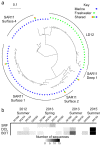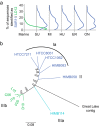Reevaluating the Salty Divide: Phylogenetic Specificity of Transitions between Marine and Freshwater Systems
- PMID: 30443603
- PMCID: PMC6234284
- DOI: 10.1128/mSystems.00232-18
Reevaluating the Salty Divide: Phylogenetic Specificity of Transitions between Marine and Freshwater Systems
Abstract
Marine and freshwater microbial communities are phylogenetically distinct, and transitions between habitat types are thought to be infrequent. We compared the phylogenetic diversity of marine and freshwater microorganisms and identified specific lineages exhibiting notably high or low similarity between marine and freshwater ecosystems using a meta-analysis of 16S rRNA gene tag-sequencing data sets. As expected, marine and freshwater microbial communities differed in the relative abundance of major phyla and contained habitat-specific lineages. At the same time, and contrary to expectations, many shared taxa were observed in both habitats. Based on several metrics, we found that Gammaproteobacteria, Alphaproteobacteria, Bacteroidetes, and Betaproteobacteria contained the highest number of closely related marine and freshwater sequences, suggesting comparatively recent habitat transitions in these groups. Using the abundant alphaproteobacterial group SAR11 as an example, we found evidence that new lineages, beyond the recognized LD12 clade, are detected in freshwater at low but reproducible abundances; this evidence extends beyond the 16S rRNA locus to core genes throughout the genome. Our results suggest that shared taxa are numerous, but tend to occur sporadically and at low relative abundance in one habitat type, leading to an underestimation of transition frequency between marine and freshwater habitats. Rare taxa with abundances near or below detection, including lineages that appear to have crossed the salty divide relatively recently, may possess adaptations enabling them to exploit opportunities for niche expansion when environments are disturbed or conditions change. IMPORTANCE The distribution of microbial diversity across environments yields insight into processes that create and maintain this diversity as well as potential to infer how communities will respond to future environmental changes. We integrated data sets from dozens of freshwater lake and marine samples to compare diversity across open water habitats differing in salinity. Our novel combination of sequence-based approaches revealed lineages that likely experienced a recent transition across habitat types. These taxa are promising targets for studying physiological constraints on salinity tolerance. Our findings contribute to understanding the ecological and evolutionary controls on microbial distributions, and open up new questions regarding the plasticity and adaptability of particular lineages.
Keywords: 16S rRNA; SAR11; aquatic ecology; aquatic microbiology; biogeography; environmental transitions; microbial ecology; tag sequencing.
Figures





Similar articles
-
Microbial ecology of northern Gulf of Mexico estuarine waters.mSystems. 2024 Aug 20;9(8):e0131823. doi: 10.1128/msystems.01318-23. Epub 2024 Jul 9. mSystems. 2024. PMID: 38980056 Free PMC article.
-
Influence of salinity on bacterioplankton communities from the Brazilian rain forest to the coastal Atlantic Ocean.PLoS One. 2011 Mar 9;6(3):e17789. doi: 10.1371/journal.pone.0017789. PLoS One. 2011. PMID: 21408023 Free PMC article.
-
A Novel Freshwater to Marine Evolutionary Transition Revealed within Methylophilaceae Bacteria from the Arctic Ocean.mBio. 2021 Jun 29;12(3):e0130621. doi: 10.1128/mBio.01306-21. Epub 2021 Jun 22. mBio. 2021. PMID: 34154421 Free PMC article.
-
Salinity tolerances and use of saline environments by freshwater turtles: implications of sea level rise.Biol Rev Camb Philos Soc. 2018 Aug;93(3):1634-1648. doi: 10.1111/brv.12410. Epub 2018 Mar 25. Biol Rev Camb Philos Soc. 2018. PMID: 29575680 Review.
-
Transitions between marine and freshwater environments provide new clues about the origins of multicellular plants and algae.J Phycol. 2017 Aug;53(4):731-745. doi: 10.1111/jpy.12547. Epub 2017 Jun 13. J Phycol. 2017. PMID: 28509401 Review.
Cited by
-
Microbial river-to-sea continuum: gradients in benthic and planktonic diversity, osmoregulation and nutrient cycling.Microbiome. 2021 Sep 20;9(1):190. doi: 10.1186/s40168-021-01145-3. Microbiome. 2021. PMID: 34544488 Free PMC article.
-
Large-scale phylogenomics of aquatic bacteria reveal molecular mechanisms for adaptation to salinity.Sci Adv. 2023 May 26;9(21):eadg2059. doi: 10.1126/sciadv.adg2059. Epub 2023 May 26. Sci Adv. 2023. PMID: 37235649 Free PMC article.
-
Salinity-driven niche differentiation within the aquatic Luna-1 subcluster.ISME Commun. 2025 Jul 16;5(1):ycaf122. doi: 10.1093/ismeco/ycaf122. eCollection 2025 Jan. ISME Commun. 2025. PMID: 40937470 Free PMC article.
-
Ecological processes shaping highly connected bacterial communities along strong environmental gradients.FEMS Microbiol Ecol. 2024 Nov 23;100(12):fiae146. doi: 10.1093/femsec/fiae146. FEMS Microbiol Ecol. 2024. PMID: 39479791 Free PMC article.
-
Phylogenetic divergence and adaptation of Nitrososphaeria across lake depths and freshwater ecosystems.ISME J. 2022 Jun;16(6):1491-1501. doi: 10.1038/s41396-022-01199-7. Epub 2022 Jan 28. ISME J. 2022. PMID: 35091647 Free PMC article.
References
-
- Cole JJ. 1982. Interactions between bacteria and algae in aquatic ecosystems. Annu Rev Ecol Syst 13:291–314. doi:10.1146/annurev.es.13.110182.001451. - DOI
Associated data
LinkOut - more resources
Full Text Sources
Research Materials

